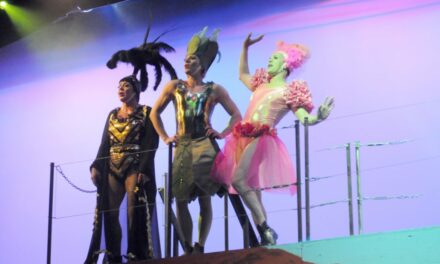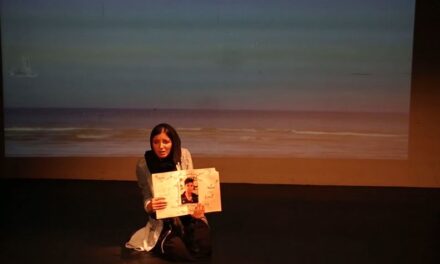There is no shortage of plays about troupes of traveling actors eking out a living on the road. To this collection of works now comes veteran Argentine dramatist Mauricio Kartun’s La vis cómica (English title: A Humorous Streak), a wry, languid work about a Spanish theatre company that arrives in Buenos Aires during the 1776-1825 Viceroyalty of the Spanish Empire but soon finds its dreams of performing curtailed by the political wrangling afoot. The said company has at its head a less than distinguished actor, Angulo the Bad (Mario Alarcón), who is traveling with his put upon wife Doña Toña (Stella Galazzi), the company’s writer Isidoro (Luis Campos), and the latter’s dog, Berganza (Cutuli), who observes the shenanigans with a sardonic sense of distance. The play charts their frustrated attempts to find a location to perform and an audience that will soak up their theatrical offerings as they make their way to Asunción—an almost mythical location where audiences will, Angulo anticipates, lap up their limited theatrical fare.
This is very much a metatheatrical piece about theatre and its discontents. Gabriela Aurora Fernández’s set boasts a worn, tired semi-circular curtain that runs across the back of the stage and a smaller curtain centre stage which serves as a space for concealment and disclosure. A trunk hides a plethora of items, serving also as a seat for the ever-weary Berganza. Berganza serves as a narrator of sorts who introduces each of the play’s five acts while offering a commentary on the ensuing action. Asides and throwaway remarks are presented about the role of the writer and director—who should always linger beneath the surface of the work—about the modest place theatre occupies—“Theatre. Robbery is worse”—and about the role theatre should play in society—“I shit on theatre with a message”. There is no attempt made to opt for Spanish accents, rather a knowing wink to a shared set of references with the Buenos Aires audience at the Sala Cunill Cabanellas—part of one of the city’s most important cluster of venues, the Teatro San Martín.
The piece offers sardonic reflections on audiences and a near-constant reiteration that what we are watching is a piece of theatre. Berganza works towards a countdown towards the denouement, reminding the audience of the structural conceits of the production evolving before them. The characters are variants on types: the vain lead actor, the no-nonsense wife, the idealistic writer, the pragmatic servant—here reenvisaged as the dog Berganza. Isidoro (with his round thick glasses) peers out at the audience with both intensity and bemusement. He wants to present his play but Angulo has other plans. And while Angulo works to exploit any opportunity that comes his way, Isidoro is more reticent to deviate from what that they have come here to do. The rosy-cheeked Toña, propped up by her ornate staff, tries to keep the ragged company afloat—not all that easy in uncertain times. Angulo’s singular, opportunistic and dangerous course of action comes to have implications for the entire company.
Kartun’s text, utilizing blank verse, creates a tension with a resolutely contemporary performance style. There are no attempts towards Spanish accents, and the colourful, layered costumes and larger than life wigs appear to smother the characters, providing an almost Brechtian sense of distancing. The pleasure for the audience lies in the winks and nods that Berganza provides. Theatre’s conventions are brutally on display and we are asked as an audience to enter into the brutal game-play of a theatricality that is always present. This includes the piece’s mutation from a Lope de Vega-like reflection on theatre and life to a gorier baroque tragicomedy on power and its abuses. Angulo strikes a pact with the Viceroyalty’s Council that compromises himself, his company and his work. While Kartun’s Terrenal (first seen in 2014) has a keener political edge in its allegorical delineation of abuses of power, A Humorous Streak is still a telling work about the ways in which art is harnessed for problematic uses, what it means to depend on patronage (or indeed subsidy) and what ethical conundrums might result from biting the hand that feeds.
Kartun’s debt to Cervantes is palpable. Angulo has been lifted as a character from an episode of Don Quixote and indeed has an element of the emaciated knight about him in Alarcón’s lean, angular physicality. A speaking dog features in Cervantes’ 1613 short story, The Dialogue of the Dog. But while Cervantes may have been the starting point for the play, its game-play and populism owe something to the sainete (humorous interlude), and the unnerving spirit of Ramón del Valle-Inclán’s bitter esperpentos (grotesque tragicomedies) hovers over the final act of the action. Alarcón’s final appearances have something of the look of a Gothic, blood-drenched Vincent Price. While I would have liked a more energetic production with more varied pacing—Kartun has been directing his work since 2003—the full house in what has proved a sell-out run responded with a standing ovation. Kartun’s treatment of an actor prepared to sell his soul to the devil provides a telling reflection on the theatre’s responsibilities and the delicate negotiation of what sometimes results in a fine line between art and propaganda.
La vis cómica/A Sense of Humour plays at the Sala Cunill Cabanellas of the Teatro San Martín Buenos Aires, until 15 December.
This post was written by the author in their personal capacity.The opinions expressed in this article are the author’s own and do not reflect the view of The Theatre Times, their staff or collaborators.
This post was written by Maria Delgado.
The views expressed here belong to the author and do not necessarily reflect our views and opinions.


















